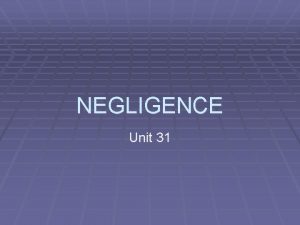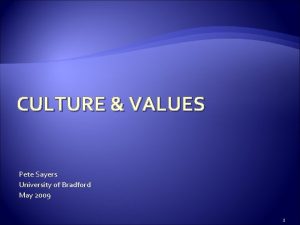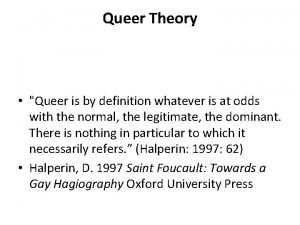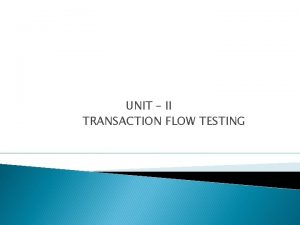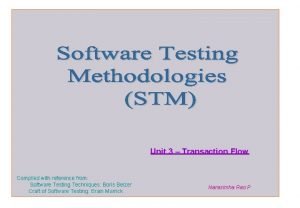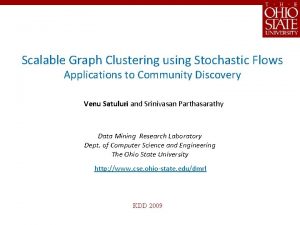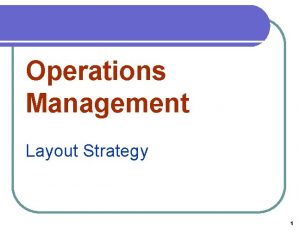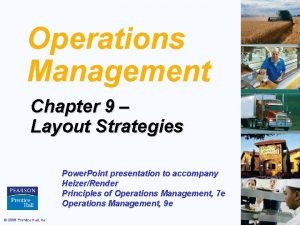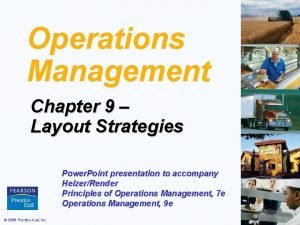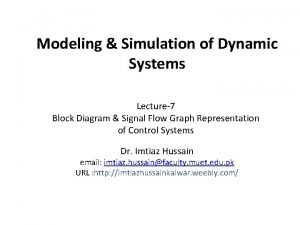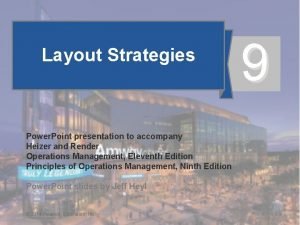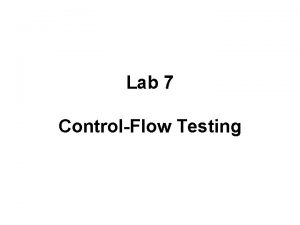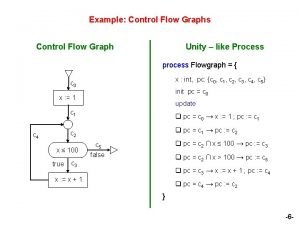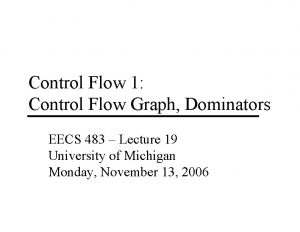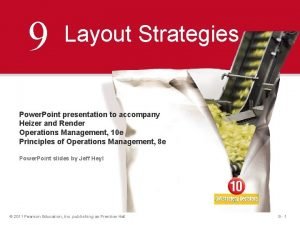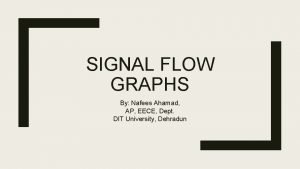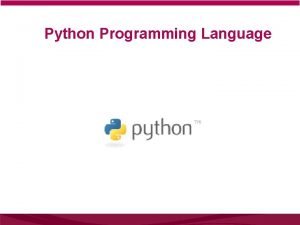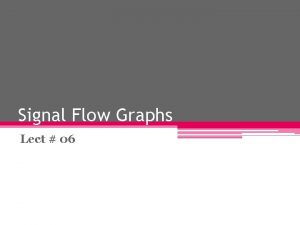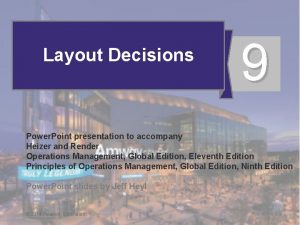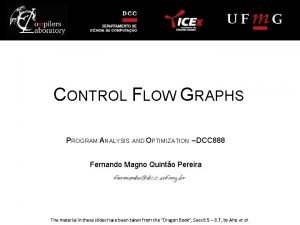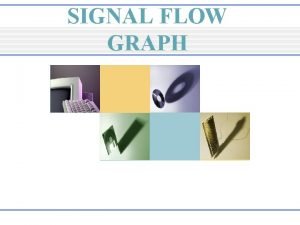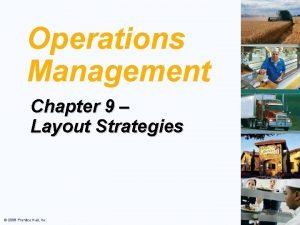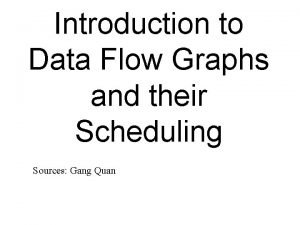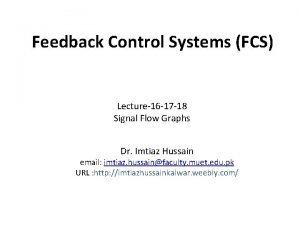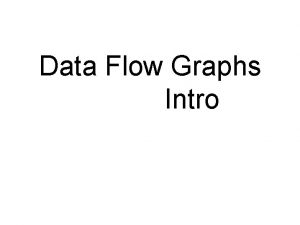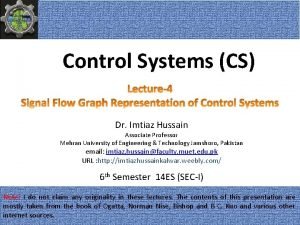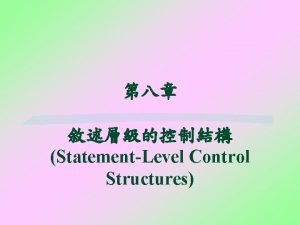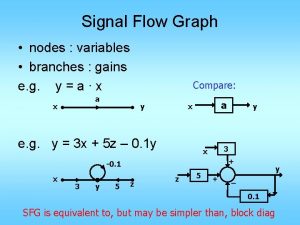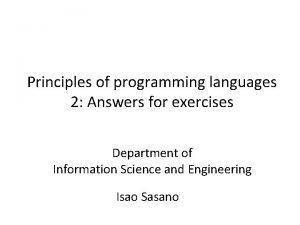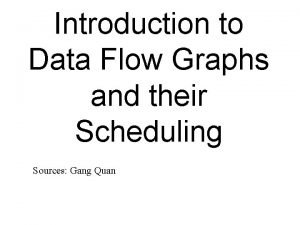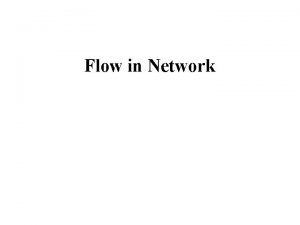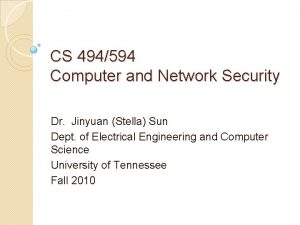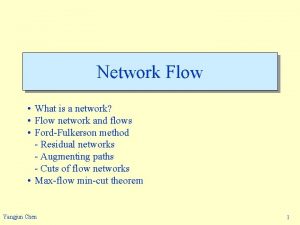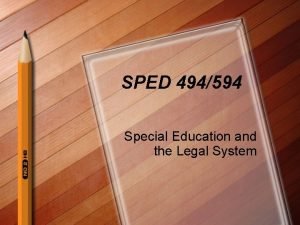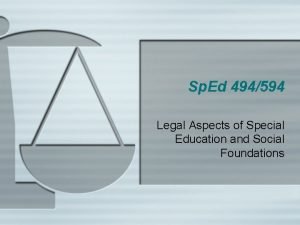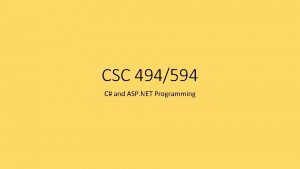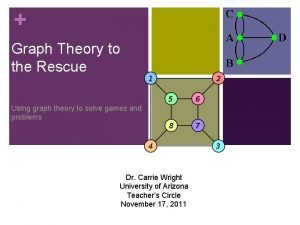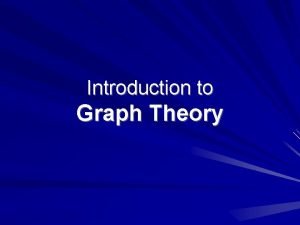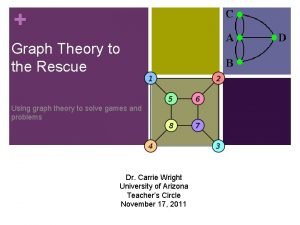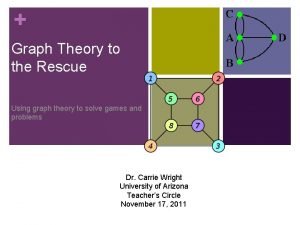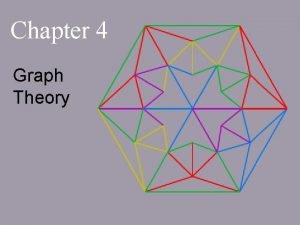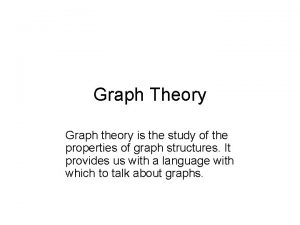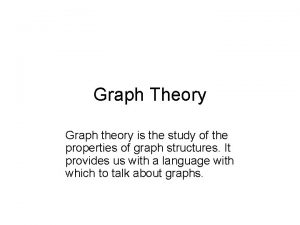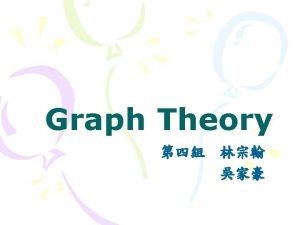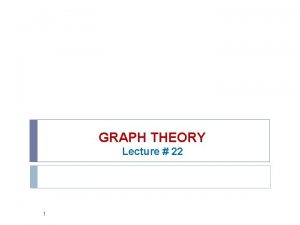Network Flow CS 494594 Graph Theory Alexander Sayers








































- Slides: 40

Network Flow CS 494/594 – Graph Theory Alexander Sayers

Contents § § § § Definitions History Examples/Algorithms Applications Open Problems References Homework

Definitions §

Maximum Flow § Image from West

Min Cut § Image from West

History § A. N. Tolstoi (1930) – “Methods of finding the minimal total kilometrage in cargo-transportation planning in space. ” – Soviet rail networks – Optimum solution does not have any negative-cost cycle in its residual graph.

History Image from Schrijver

History § T. E. Harris and General F. S. Ross (1955) – “Fundamentals of a Method for Evaluating Rail Net Capacities” – Formulated the network flow problem. – “Consider a rail network connecting two cities by way of a number of intermediate cities, where each link of the network has a number assigned to it representing its capacity. Assuming a steady state condition, find a maximal flow from one given city to the other. ”

History § L. R. Ford and D. R. Fulkerson (1956) – “Maximal Flow through a Network” – Proposed the Ford-Fulkerson Algorithm that works in the “cases of most practical interest” by taking advantage of the network planarity.

Ford-Fulkerson Algorithm § Algorithm – Begin with edges initialized to a flow of 0. – While there is a path (no specific path choosing method) from source to sink with capacity remaining. • Increase the flow on each edge, by the amount equal to the minimum of the residual capacities of the edges on the path. • Establish edges in the reverse direction of equal flow. – Continue until there is no such path remaining. – The flow into the sink is the maximum flow.

Failures of FF Algorithm § Pathological scenarios Image from Wiki § Failure to halt – Ford and Fulkerson gave as an example a network with 10 vertices and 48 edges on which their algorithm may fail to halt. – Zwick proved that the smallest possible example of failing to halt is a network that has only 6 vertices and 8 edges.

Failures of FF Algorithm §

Failures of FF Algorithm Residual Values Step Augment. path Sent Flow e 1 e 2 0 1 1 1 0 2 0 3 4 5 e 3 0 0 0 Image from Wiki

History § E. A. Dinitz (1970) – “Algorithm for solution of a problem of maximum flow in a network with power estimation. ” – First publication of the Edmonds-Karp Algorithm. – Created Dinitz’s Algorithm. Image from http: //www. cs. bgu. ac. il/~dinitz/

History § J. Edmonds and R. M. Karp (1972) – “Theoretical improvements in algorithmic efficiency for network flow problems. ” – Independently published the Edmonds-Karp Algorithm. Image from http: //www. iasi. cnr. it/jack/ Image from UC Berkley

Edmonds-Karp/Dinitz’s Alg. §

History § R. K. Ahuja, T. L. Magnanti and J. B. Orlin (1993) – “Network Flow: Theory, Algorithms, and Applications. ” – Developed a faster algorithm (a strongly polynomial running time algorithm) to solve network problems.

History Image from Asano

Applications § § § § Edge Disjoint Paths Bipartite Matching Baseball Elimination Problem Project Selection Image Segmentation Open Pit Mining Survey Design And many more (Ahuja, Magnanti, Orlin and Reddy came up with a very complete list of applications).

Baseball Elimination Problem § Goal: – Calculate which teams can still win given all possible outcomes of remaining games. – Winning involves having won the most (or equal most) games at the conclusion of all games.

Baseball Elimination Problem § Example: Atlanta 83 71 8 Philly 80 79 3 New York 78 78 6 Montreal 77 82 3 § Based on the above information, which teams can still win (most, or tied most number of wins)?

Baseball Elimination Problem § Let’s add some information: Atl. Philly NY Mont. Atlanta 83 71 8 - 1 6 1 Philly 80 79 3 1 - 0 2 New York 78 78 6 6 0 - 0 Montreal 77 82 3 1 2 0 - § Based on the above new information, which teams can still win (most, or tied most number of wins)?

Baseball Elimination Problem §

Baseball Elimination Problem § Calculating whether New York can win: AP A 1 1 s 1 AM P 4 t 7 2 PM M § If all the games flow through, then they can.

Baseball Elimination Problem § s t

Project Selection § Goal: – Choose a feasible subset of projects to maximize revenue.

Project Selection §

Project Selection § Illustration of feasibility: Image from Wayne

Project Selection § Image from Wayne

Project Selection § Image from Wayne

Image Segmentation § Goal: – Identify foreground and background in a complex scene.

Image Segmentation §

Image Segmentation § Objective is to maximize the following: § Turn this into a minimization problem: Image from Wayne

Image Segmentation § Image from Wayne

Open Problems §

References § § § § § Ahuja, R. K. ; Magnanti, T. L. ; Orlin, J. B. (1993). “Network flow: theory, algorithms, and applications”. Prentice Hall. Ahuja, R. K. ; Magnanti, T. L. ; Orlin, J. B. ; Reddy, M. R. (June 1994). “Applications of network optimization”. Asano, T. ; Asano, Y. (2000) “Recent developments in maximum flow algorithms”. Journal of the Operations Research. Society of Japan 43 (2). Biedl, T. C. ; Brejova, B. ; Vinar, T. (2000). “Simplifying flow networks”. Department of Computer Science, University of Waterloo. Dinic, E. A. (1970). "Algorithm for solution of a problem of maximum flow in a network with power estimation". Soviet Math. Doklady (Doklady) 11: 1277– 1280. Edmonds, Jack; Karp, Richard M. (1972). "Theoretical improvements in algorithmic efficiency for network flow problems". Journal of the ACM (Association for Computing Machinery) 19 (2): 248– 264. Ford, L. R. ; Fulkerson, D. R. (1956). "Maximal flow through a network". Canadian Journal of Mathematics 8: 399. Schrijver, Alexander (2002). “On the history of the transportation and maximum flow problems. ” [51] Schrijver, A. West, Douglas B. (2001). “Introduction to Graph Theory (2 nd Edition). ” Pearson Education.

References § Zwick, Uri (21 August 1995). "The smallest networks on which the Ford-Fulkerson maximum flow procedure may fail to terminate". Theoretical Computer Science 148 (1): 165– 170.

Homework §

Homework § 2) Given a directed graph where the vertices are assigned maximum capacities as well as the edges. Describe/illustrate how you would calculate maximum flow of this graph using established network flow theory/algorithms?

Questions
 Sayers v harlow
Sayers v harlow Bradford may
Bradford may Bridge graph
Bridge graph Game theory and graph theory
Game theory and graph theory Define queer theory
Define queer theory Wait-for graph
Wait-for graph Transaction flow testing
Transaction flow testing Transaction flow testing
Transaction flow testing Application of data flow testing
Application of data flow testing Graph clustering by flow simulation
Graph clustering by flow simulation What is layout strategy
What is layout strategy Product oriented layout example
Product oriented layout example Process layout in operations management
Process layout in operations management Signal flow diagram
Signal flow diagram Process layout example
Process layout example Control flow graph for bubble sort
Control flow graph for bubble sort Control flow graph examples
Control flow graph examples Control flow graph
Control flow graph Linearly independent paths in control flow graph
Linearly independent paths in control flow graph Interdepartmental flow graph
Interdepartmental flow graph Graph matrix in white box testing
Graph matrix in white box testing Signal flow graph examples
Signal flow graph examples Control flow graph python
Control flow graph python Define signal flow graph
Define signal flow graph Interdepartmental flow graph
Interdepartmental flow graph Control-flow graph
Control-flow graph Control flow graph for bubble sort
Control flow graph for bubble sort Non touching loop example
Non touching loop example Interdepartmental flow graph
Interdepartmental flow graph The use of flow charts and graphs for scheduling
The use of flow charts and graphs for scheduling Ghidra control flow graph
Ghidra control flow graph Signal flow
Signal flow Flow graph
Flow graph Live variable analysis in compiler design
Live variable analysis in compiler design Forward path in signal flow graph
Forward path in signal flow graph Flow graph
Flow graph Transaction flow graph
Transaction flow graph Sequential control structure
Sequential control structure How to draw signal flow graph from circuit
How to draw signal flow graph from circuit Control flow graph
Control flow graph Data flow graph examples
Data flow graph examples
